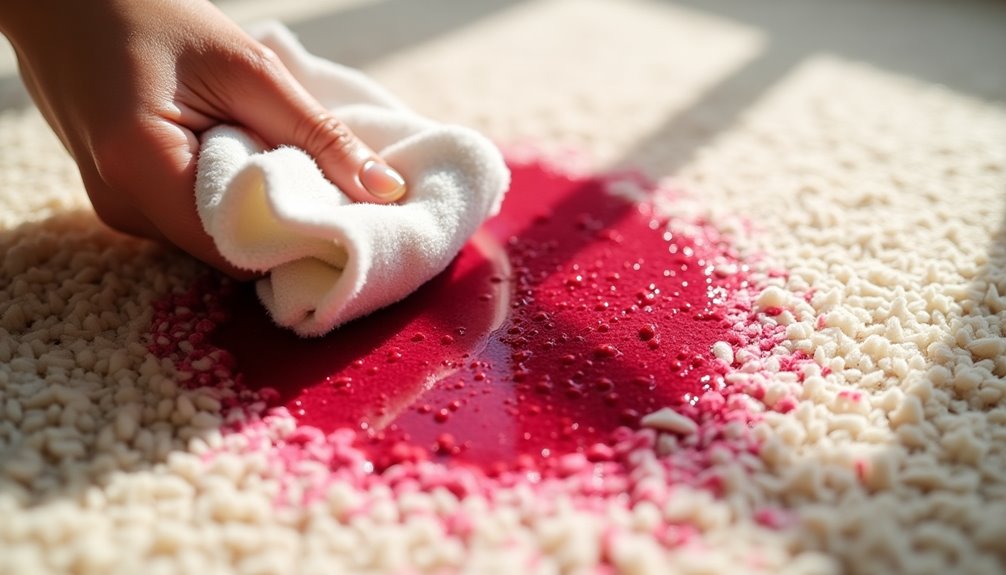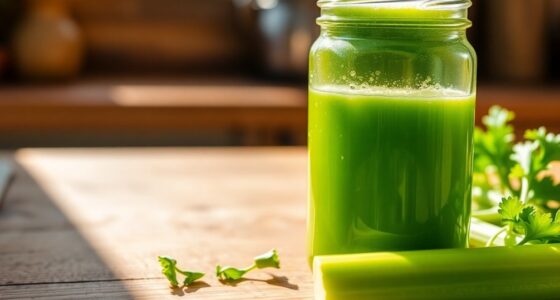To get beet juice out of your carpet, act fast! Start by dabbing the stain with a dry cloth to absorb excess juice. Rinse the area with cold water, then mix one teaspoon of dishwashing detergent with one cup of cold water. Apply it gently to the stain, letting it sit a few minutes. If needed, use a vinegar solution for stubborn stains. Finally, rinse again and let the carpet air dry. There's more to ensure your carpet stays fresh!
Key Takeaways
- Quickly absorb excess beet juice with a dry cloth, dabbing gently to prevent the stain from seeping deeper into the carpet fibers.
- Rinse the stained area with cold water to dilute the beet juice, avoiding hot water that could set the stain.
- Prepare a cleaning solution by mixing one teaspoon of liquid dishwashing detergent with one cup of cold water, applying it gently to the stain.
- For stubborn stains, use a vinegar solution (one part vinegar to two parts water), allowing it to sit before blotting with a clean cloth.
- Always test cleaning solutions on an inconspicuous area first, and ensure the carpet dries completely to prevent mildew.

Beet juice can be a vibrant addition to your meals, but when it spills on your carpet, it can quickly become a headache. The rich color of beet juice can turn a simple mishap into a stubborn stain that's difficult to tackle. However, if you act fast, you can minimize the damage and restore your carpet to its original state. Here's how to efficiently deal with that beet juice stain.
First, you should immediately grab a dry cloth. The goal here is to absorb as much of the excess liquid as possible before it seeps deeper into the carpet fibers. Gently dab the stain, but don't rub it. Rubbing can spread the stain, making your cleaning efforts more challenging.
Once you've absorbed the excess beet juice, it's important to use cold water for rinsing the area. Avoid hot water, as it can set the stain, making it even harder to remove.
After rinsing with cold water, prepare a cleaning solution. Mix one teaspoon of liquid dishwashing detergent with a cup of cold water. This mixture acts as a gentle but effective cleaning solution for the beet juice stain.
Using a clean cloth or sponge, gently apply the cleaning solution to the stain, working from the outer edge toward the center. This method helps prevent the stain from spreading further. Allow the solution to sit for a few minutes, giving it time to break down the stain.
If the stain persists after your initial treatment, you might need to up your game. Consider using a mixture of one part white vinegar to two parts water. Vinegar is a powerful natural cleaner and can help lift stubborn stains.
Apply this solution to the stain and let it sit for a few minutes. Afterward, blot it up with a clean, dry cloth. Keep dabbing until the cloth comes away clean, and make sure you continue to absorb any excess liquid.
Throughout this process, remember to test any cleaning solution on an inconspicuous area of your carpet first. You want to ensure it doesn't cause discoloration or damage. Your carpet's material may react differently, so it's always better to be cautious.
Finally, once you've successfully removed the beet juice stain, you can give the area a final rinse with cold water to clear out any remaining cleaning solution. After rinsing, use a dry cloth to absorb as much moisture as possible.
It's essential to allow the carpet to air dry thoroughly to prevent any mildew or unpleasant odors.
Frequently Asked Questions
How Do You Remove Beet Juice From Carpet?
To remove beet juice from your carpet, act quickly!
Start by dabbing the stain with a dry cloth to soak up excess liquid.
Mix one teaspoon of liquid dish detergent with a cup of cold water, applying it from the edges to the center.
Gently blot until the stain lifts.
If it's stubborn, try a vinegar solution or a baking soda paste.
Always test any cleaner in an inconspicuous spot first to avoid damage.
Do Beet Juice Stains Come Out?
Did you know that 70% of carpet stains can be removed if treated within the first 24 hours?
So, yes, beet juice stains can come out, but timing's crucial. If you act quickly, you'll have a better chance of lifting the stain.
Use cold water and gentle solutions like dish soap or vinegar. If you don't see improvement, don't hesitate to call in professionals for help.
Regular maintenance can also prevent lasting damage!
What Is the Best Stain Remover for Beetroot Stains?
The best stain remover for beetroot stains combines dish soap and cold water.
Mix them, apply to the stain, and blot gently.
If that doesn't work, try a diluted solution of white vinegar—one part vinegar to two parts water—letting it sit before blotting.
For tougher stains, you can use hydrogen peroxide, but test it first to avoid discoloration.
Baking soda paste is also great; just let it dry before vacuuming.
What Gets Red Juice Out of Carpet?
To get red juice out of your carpet, start by blotting the stain with a clean cloth soaked in cold water. This helps lift excess liquid without spreading the stain.
Next, mix one tablespoon of liquid dish detergent with two cups of cold water and gently blot the area.
If the stain persists, try a vinegar solution or a paste of baking soda and water for added absorption before vacuuming.
Conclusion
Now that you've mastered the art of banishing beet juice from your carpet, you're practically a cleaning wizard! With just a sprinkle of baking soda and a splash of vinegar, those deep crimson stains don't stand a chance. Imagine your friends marveling at your carpet's flawless glory, wondering if it's enchanted! So, go ahead and unleash your newfound skills—your carpet deserves to sparkle like the crown jewels, and you're the hero it needs in this epic battle against beet stains!
Cindy thoroughly researches juicing trends, techniques, and recipes to provide readers with practical advice and inspiration. Her writing style is accessible, engaging, and designed to make complex concepts easy to understand. Cindy’s dedication to promoting the advantages of juicing shines through her work, empowering readers to make positive changes in their lives through the simple act of juicing.
















